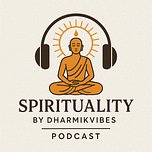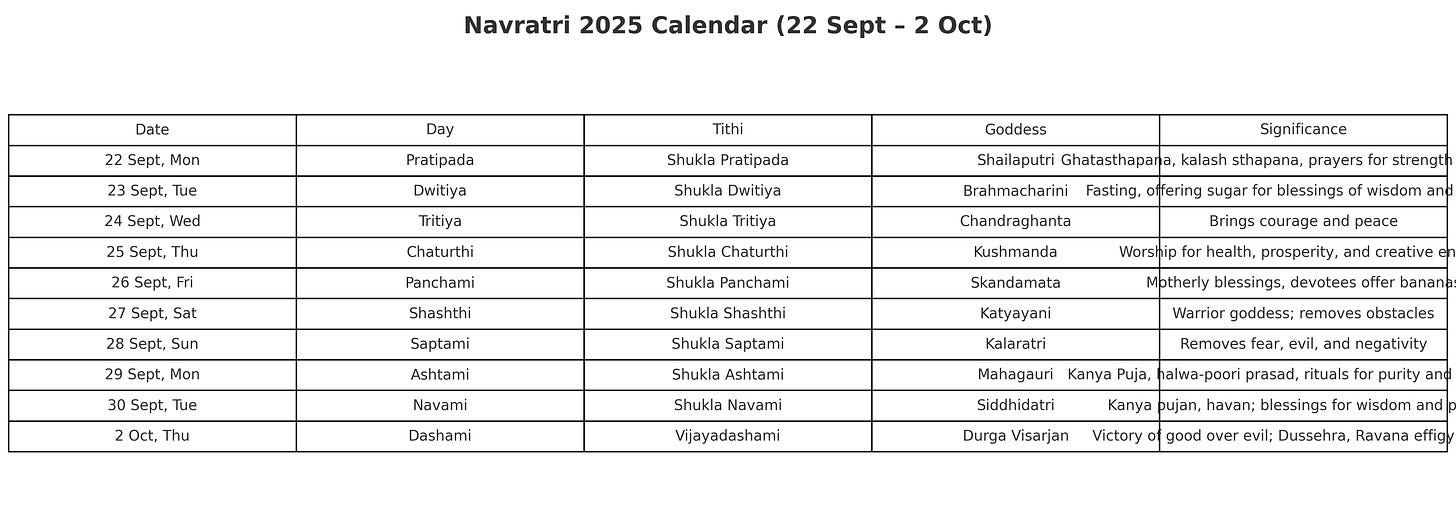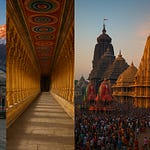Navratri, meaning “nine nights”, is one of the most revered Hindu festivals celebrated across India and worldwide. In 2025, Sharadiya (autumnal) Navratri begins on Monday, 22 September and ends with Vijayadashami (Dussehra) on Thursday, 2 October. Each day honors a different manifestation of Goddess Durga and symbolizes the triumph of good over evil.
Spiritual Significance
Navratri is deeply rooted in Hindu mythology. It commemorates the victory of Goddess Durga over the buffalo demon Mahishasura, representing the triumph of righteousness (dharma) over evil (adharma). In some regions, it also aligns with Lord Rama’s victory over Ravana, celebrated as Dussehra.
The festival marks seasonal transitions, combining devotion, fasting, dance, music, and cultural performances. It is also a period of spiritual cleansing and inner discipline.
Navratri 2025 Dates and Daily Significance
Day 1 – Pratipada (22 Sept, Mon): Worship of Shailaputri (daughter of the mountains). Symbol of strength and stability.
Ritual: Ghatasthapana (kalash installation) marks the beginning of Navratri.
Day 2 – Dwitiya (23 Sept, Tue): Worship of Brahmacharini, the ascetic form of Parvati.
Symbol of penance, wisdom, and devotion.
Day 3 – Tritiya (24 Sept, Wed): Worship of Chandraghanta.
Brings peace, serenity, and courage.
Day 4 – Chaturthi (25 Sept, Thu): Worship of Kushmanda, creator of the universe with her cosmic energy.
Day 5 – Panchami (26 Sept, Fri): Worship of Skandamata, mother of Kartikeya (Skanda).
Symbolizes maternal love and compassion.
Day 6 – Shashthi (27 Sept, Sat): Worship of Katyayani.
Fierce warrior goddess who destroys demons.
Day 7 – Saptami (28 Sept, Sun): Worship of Kalaratri.
Fierce form of Goddess who removes fear, negativity, and ignorance.
Day 8 – Ashtami (29 Sept, Mon): Worship of Mahagauri.
Symbolizes purity, forgiveness, and calmness. Kanya Pujan (worship of young girls) is observed.
Day 9 – Navami (30 Sept, Tue): Worship of Siddhidatri.
Bestows wisdom, power, and spiritual fulfillment. Kanya pujan and Havan rituals are performed.
Day 10 – Vijayadashami/Dussehra (2 Oct, Thu): Symbolizes the victory of good over evil. Effigies of Ravana are burnt, dramatizing Rama’s victory.
Rituals and Traditions
Ghatasthapana: Beginning of Navratri with installation of kalash and sowing of barley seeds.
Daily Aarti & Fasting: Devotees perform morning and evening aartis and observe fasts (phalahar – fruits, milk, vrat recipes).
Garba & Dandiya: In Gujarat and many cities worldwide, people celebrate through night-long dance and music.
Kanya Pujan: On Ashtami/Navami, young girls are worshipped as forms of Goddess Durga.
How to Celebrate Navratri
At Home: Set up an altar with images or idols of Goddess Durga, keep the kalash, offer flowers, incense, fruits, and sweets.
Temples to Visit:
Vaishno Devi (Jammu) – Sacred cave shrine of Maa Vaishnavi.
Kamakhya Temple (Assam) – Shaktipeeth dedicated to Maa Kamakhya.
Dakshineswar Kali Temple (Kolkata) – Dedicated to Goddess Kali.
Chamundeshwari Temple (Mysuru) – Famous during Dussehra.
Ambaji Temple (Gujarat) – Major pilgrimage site during Navratri.
Cultural Festivities: Join Garba/Dandiya events, attend Ram Leela plays, and witness Dussehra processions.
Fasting (Vrat) Rules: What to Do and Avoid
What to Eat (Satvik Food):
Fruits, milk, curd, nuts, kuttu ka atta (buckwheat flour), singhara atta, sabudana, potatoes, sweet potato, samak rice, makhana, and rock salt (sendha namak).
What to Avoid:
Onion, garlic, wheat, rice, pulses, alcohol, meat, and common salt.
How to Observe the Fast:
Many devotees do Nirjala Vrat (without water) for a day, while others opt for phalahar (fruit-based) fasting.
Break fast after evening aarti with prasad.
Do’s and Don’ts During Navratri
Do’s:
Maintain cleanliness and purity at home.
Offer fresh flowers and seasonal fruits daily.
Participate in aarti and bhajans.
Respect young girls and women, as they are symbolic of the Goddess.
Don’ts:
Avoid cutting hair, trimming nails, or shaving during Navratri.
Do not consume alcohol, tobacco, or non-vegetarian food.
Avoid anger, lies, and negative speech.
Navratri 2025, from 22 September to 2 October, is not just a festival but a journey of devotion, discipline, and spiritual upliftment. It unites communities through music, dance, worship, and cultural festivities. Whether you are fasting, visiting temples, or celebrating with Garba, the essence of Navratri lies in seeking inner strength and divine blessings.













